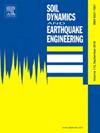考虑SSI和变深空间运动输入的不规则弯曲预制节段桥墩整体抗震性能评价
IF 4.2
2区 工程技术
Q1 ENGINEERING, GEOLOGICAL
引用次数: 0
摘要
预制节段墩(PSP)由于其施工速度快、环境影响小等优点,被认为是一种很有前途的加速桥梁施工技术。此外,不规则曲线桥梁因其对复杂地形的适应能力而在桥梁设计中被广泛采用。然而,对不规则弯曲桥的抗震性能的有限了解阻碍了预制墩施工方法的广泛应用。本文提出了一种概率方法,用于数值评估icbs - psp在变深空间地震运动(DSSMs)下的抗震性能。系统研究了土-结构相互作用(SSI)、地震运动输入类型、水平曲率和墩柱类型对其抗震性能的影响。为此,首先在OpenSees中建立了考虑SSI效应的代表性icb - psp的有限元模型。应用于icb - psp的非均匀位置的dssm是随机合成的,并作为计算结构地震响应的输入。最后,采用基于人工神经网络的概率地震需求模型计算了范例桥的地震易损性。数值结果强调了在评估icbs - psp的抗震性能时,考虑SSI和使用合理的dssm作为输入的重要性。此外,还应充分考虑水平曲率对其抗震性能的影响。与现浇整体式桥墩(MPs)相比,ICB-PSPs桥墩在减少地震事件后的残余位移方面表现出色。该方法可以全面了解异质场地上建造的ICBs-PSPs的抗震性能,为进一步扩大PSPs在桥梁设计和施工中的应用提供重要参考。本文章由计算机程序翻译,如有差异,请以英文原文为准。
A holistic seismic performance evaluation of irregular curved bridges with precast segmental piers considering SSI and depth-varying spatial motion inputs
The precast segmental pier (PSP) is recognized as a promising technique for accelerated bridge construction due to its advantages of faster construction speeds and lower environmental consequences. Moreover, irregular curved bridges are commonly adopted in bridge design because of their adaptability to complex terrains. However, limited understanding of the seismic behavior of irregular curved bridges with PSPs (ICBs-PSPs) has impeded the broader application of the precast pier construction approach. This paper proposes a probabilistic method for numerically assessing the seismic performance of ICBs-PSPs subjected to depth-varying spatial seismic motions (DSSMs). The influences of soil-structure interaction (SSI), seismic motion input types, horizontal curvature, and pier column types on its seismic behavior are also systematically investigated. For this purpose, the FE model of a representative ICB-PSPs considering SSI effect is firstly developed in OpenSees. The DSSMs at heterogeneous sites applied to the ICB-PSPs are stochastically synthesized and utilized as inputs to calculate the structural seismic response. Finally, probabilistic seismic demand models based on artificial neural network are employed to compute the seismic fragility of the exemplar bridge. The numerical results underscore the importance of considering SSI and using reasonable DSSMs as input when assessing the seismic behavior of ICBs-PSPs. Moreover, the effect of horizontal curvature on their seismic behavior should be fully taken into account. Compared to the bridge with cast-in-place monolithic piers (MPs), the ICB-PSPs excels in reducing residual displacement after seismic events. The proposed approach can provide a comprehensive understanding of the seismic behavior of ICBs-PSPs constructed on heterogeneous sites, thereby offering vital references for further expanding the application of PSPs in bridge design and construction.
求助全文
通过发布文献求助,成功后即可免费获取论文全文。
去求助
来源期刊

Soil Dynamics and Earthquake Engineering
工程技术-地球科学综合
CiteScore
7.50
自引率
15.00%
发文量
446
审稿时长
8 months
期刊介绍:
The journal aims to encourage and enhance the role of mechanics and other disciplines as they relate to earthquake engineering by providing opportunities for the publication of the work of applied mathematicians, engineers and other applied scientists involved in solving problems closely related to the field of earthquake engineering and geotechnical earthquake engineering.
Emphasis is placed on new concepts and techniques, but case histories will also be published if they enhance the presentation and understanding of new technical concepts.
 求助内容:
求助内容: 应助结果提醒方式:
应助结果提醒方式:


